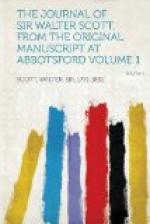We went to Cashiobury, belonging to the Earl of Essex, an old mansion, apparently, with a fine park. The Colne runs through the grounds, or rather creeps through them.
“For the Colne
Is black and swollen,
Snake-like, he
winds his way,
Unlike the burns
From Highland urns
That dance by
crag and brae.”
Borthwick-brae[218] came to dinner from town, and we had a very pleasant evening. My excellent old friend reminded me of the old and bitter feud between the Scotts and the Haliburtons, and observed it was curious I should have united the blood of two hostile clans.
May 28.—We took leave of our kind old host after breakfast, and set out for our own land. Our elegant researches carried us out of the high-road and through a labyrinth of intricate lanes,—which seem made on purpose to afford strangers the full benefit of a dark night and a drunk driver,—in order to visit Gill’s Hill, famous for the murder of Mr. Weare.
The place has the strongest title to the description of Wordsworth:—
“A merry spot, ’tis
said, in days of yore,
But something ails it now—–
the place is cursed.”
The principal part of the house has been destroyed, and only the kitchen remains standing. The garden has been dismantled, though a few laurels and garden shrubs, run wild, continue to mark the spot. The fatal pond is now only a green swamp, but so near the house that one cannot conceive how it was ever chosen as a place of temporary concealment of the murdered body. Indeed the whole history of the murder, and the scenes which ensued, are strange pictures of desperate and short-sighted wickedness. The feasting—the singing—the murderer with his hands still bloody hanging round the neck of one of the females—the watch-chain of the murdered man, argue the utmost apathy. Even Probert, the most frightened of the party, fled no further for relief than to the brandy bottle, and is found in the very lane, and at the spot of the murder, seeking for the murderous weapon, and exposing himself to the view of the passengers. Another singular mark of stupid audacity was their venturing to wear the clothes of their victim. There was




